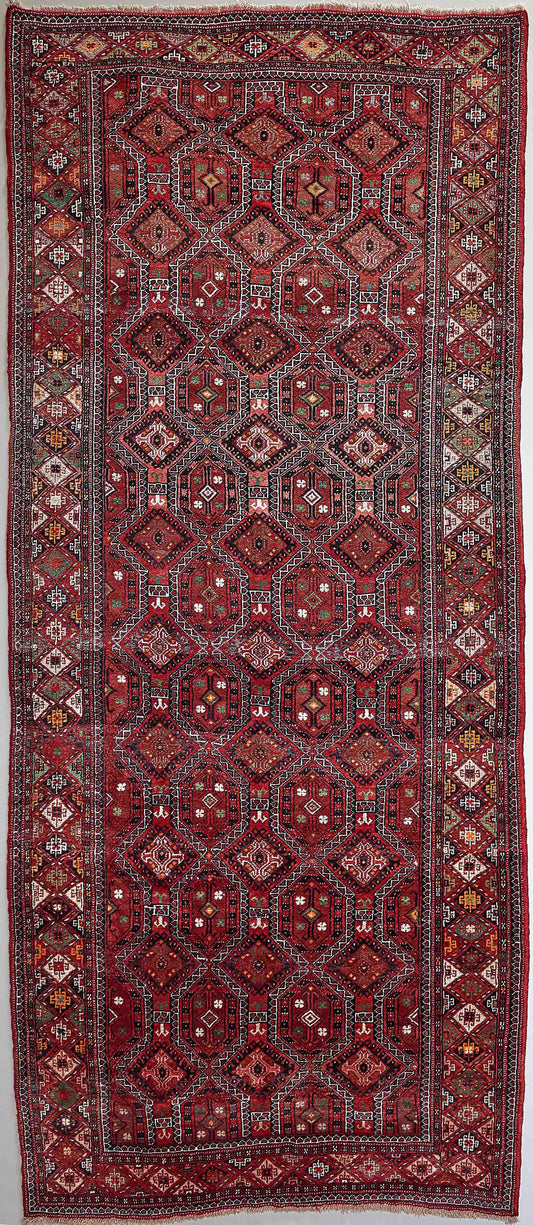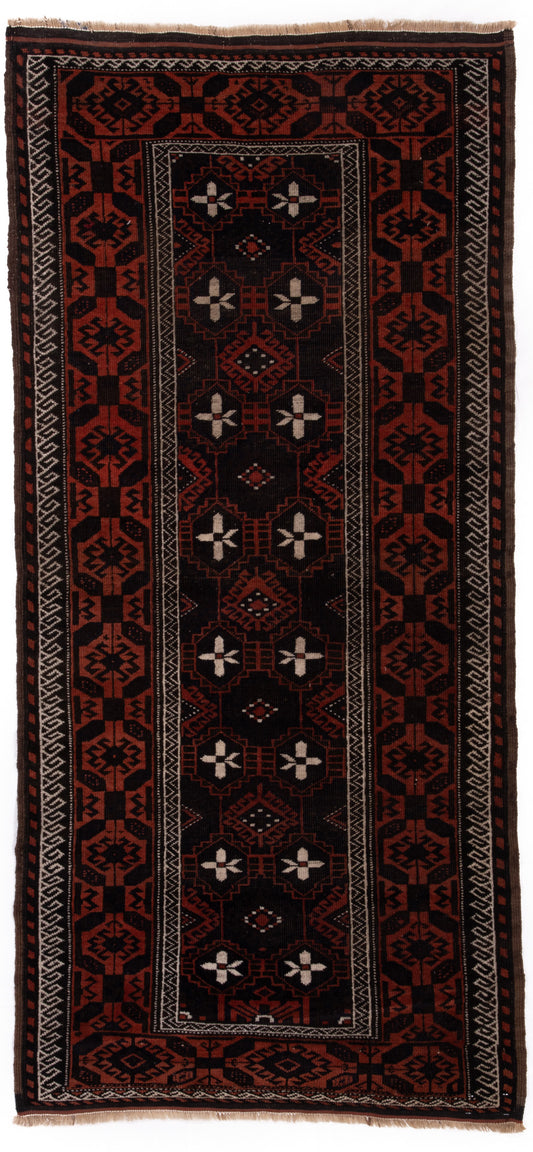Baluch Rug History & Origin Guide
A Comprehensive Guide to Baluch Rugs
Introduction to Baluch Rugs
Discover the fascinating world of Baluch rugs, a true testament to the rich cultural heritage of the nomadic tribes living on the border of Iran and Afghanistan. These striking and resilient rugs are known for their intricate geometric designs, natural dyes, and traditional weaving techniques. In this guide, we will delve into the history, colours, patterns, and materials used in creating these unique rugs.
Materials and Construction
Baluch rugs are crafted using a combination of natural materials, which contribute to their durability and characteristic charm.
Common materials used
- Cotton: Often used as the foundation for the rugs, cotton provides a strong and stable base for the intricate patterns and knots.
- Wool: Typically used for the pile, wool adds a soft and luxurious feel to the rugs. The high-quality sheep wool is also known for its excellent resilience.
- Goat and camel hair: Occasionally incorporated into the weft or used for decorative elements, goat and camel hair add a unique touch to these tribal rugs.
Looms and weaving techniques
Baluch rugs are usually woven using asymmetrical knots, with each rug boasting a knot count of over 100 knots per square inch. These rugs are crafted on horizontal looms, with a normal area-sized rug taking up to ten months with weavers working six hours a day.
Design and Patterns
The captivating designs and patterns of Baluch rugs are a reflection of the rich cultural heritage of the Baluchi tribes. Let's explore some of the most common patterns and motifs found in these rugs.
Geometric motifs
Baluch rugs often feature geometric motifs, such as hexagons, rectangles, and triangles, to create visually striking patterns. These motifs showcase the skilled craftsmanship and artistic vision of the weavers.
Camel print and gul repeat medallions
Camels are significant to Baluchi tribes, and their importance is often represented in the form of camel prints and 'gul' repeat medallions in Baluch rugs. These symbolic elements add depth and cultural context to the rug designs.
Unique characteristics
One of the distinctive features of Baluch rugs is the repetition of a singular pattern throughout the rug. This repetition creates a visually captivating effect, adding to the overall allure of these tribal rugs.
Colours and Dyes
The colours used in Baluch rugs are both vibrant and earthy, reflecting the natural landscape and cultural influences of the region.
Use of natural dyes
Baluch rugs are typically dyed using natural sources, such as plants, insects, and minerals. This process imbues the rugs with rich, organic hues and ensures their lasting beauty.
Common colours
Dark shades of red, blue, grey, and brown are frequently used in Baluch rugs, often contrasted with white, ivory, yellow, or orange patterns. The heavy use of black outlines and black shades adds depth and intensity to the original colours, creating a visually stunning effect.
Climate and Environmental Influence
The climate and environment of the Baluchistan region play a significant role in the creation and characteristics of Baluch rugs.
Harsh climate
Baluchistan experiences a predominantly arid and semi-arid climate, with hot summers and cold winters. This harsh environment has shaped the lifestyle and resourcefulness of the Baluchi tribes, which is reflected in the durability and resilience of their rug designs.
Natural materials
The materials used in Baluch rugs, such as wool, cotton, and goat or camel hair, are sourced locally from the region's livestock. These natural resources contribute to the sustainable and eco-friendly nature of these traditional rugs.
Visiting the Baluchistan Region
While not a typical tourist destination, the Baluchistan region offers a unique cultural experience for those interested in exploring the origins of Baluch rugs and the lifestyle of the Baluchi tribes.
Cultural immersion
Visiting the Baluchistan region provides an opportunity to witness the traditional weaving techniques, learn about the natural dyeing process, and gain a deeper understanding of the rich cultural heritage of the Baluchi tribes.
Places of significance
While in the region, you can explore places of historical and cultural significance, such as ancient ruins, local bazaars, and traditional villages. These locations offer a glimpse into the everyday life and customs of the Baluchi people.
Responsible tourism
When visiting the Baluchistan region, it's essential to practice responsible tourism by respecting local customs, supporting local artisans, and minimizing your environmental impact. This approach ensures a meaningful and mutually beneficial experience for both visitors and local communities.
Conclusion
Baluch rugs are an incredible representation of the rich cultural history and skilled craftsmanship of the Baluchi tribes. Their unique designs, patterns, and materials tell the story of a resilient people adapting to their environment and preserving their heritage. By exploring the origins of these rugs and understanding the techniques and traditions behind their creation, we can appreciate the true value and beauty of these exceptional works of art.
Tips for Buying and Caring for Baluch Rugs
When considering adding a Baluch rug to your collection or home décor, it's essential to keep some tips in mind for making an informed decision and ensuring the longevity of your rug.
Know the origin and authenticity
When purchasing a Baluch rug, it's crucial to ensure its authenticity and origin. Look for reputable dealers who can provide information about the rug's provenance, materials, and craftsmanship. Familiarize yourself with Baluch rug characteristics to help you identify genuine pieces.
Choose the right size and design
Consider the intended space and purpose for the rug when selecting a size and design. Baluch rugs are often limited in size due to their tribal origins, so be mindful of the dimensions when choosing the perfect piece for your home.
Proper cleaning and maintenance
To preserve the beauty and durability of your Baluch rug, clean it regularly and handle it with care. Vacuum your rug gently to remove dirt and debris, and consider professional cleaning every few years to maintain the rug's appearance and extend its lifespan. Keep your rug away from direct sunlight to prevent fading and avoid placing heavy furniture on it to prevent damage to the fibers.
Appreciate the history and craftsmanship
Baluch rugs are more than just decorative items; they carry a rich history and cultural significance. By understanding and appreciating the story behind these rugs, you can truly cherish the artistry and craftsmanship that goes into their creation.
Supporting Baluch Artisans
By purchasing and appreciating Baluch rugs, you can contribute to the preservation of this unique art form and support the livelihoods of Baluch artisans. Here are some ways to make a positive impact:
Buying from reputable sources
Purchase Baluch rugs from reputable dealers and artisans who uphold fair trade practices, ensuring that the weavers receive fair compensation for their work.
Promoting awareness
Share your knowledge of Baluch rugs and their cultural significance with friends, family, and your community. By promoting awareness, you can help generate interest in and appreciation for this unique art form.
Preserving traditions
By supporting Baluch artisans, you contribute to the preservation of traditional weaving techniques and cultural heritage, ensuring that future generations can continue to create and appreciate these beautiful rugs.
Final Thoughts
Baluch rugs are a testament to the resilience and creativity of the Baluchi tribes, reflecting their rich cultural history and exceptional craftsmanship. By learning about the origins, characteristics, and techniques behind these rugs, we can develop a deeper appreciation for their beauty and significance. By supporting Baluch artisans and promoting awareness of this unique art form, we can contribute to the preservation of these traditions and the livelihoods of the talented individuals who bring these rugs to life.
Explore our comprehensive range of Baluch rugs today.
Browse Our Current Selection of Baluch Rugs
-
Afghan Baluch Rug
Regular price £395.00Regular priceUnit price / per -
 Sold
SoldAfghan Baluch Rug
Regular price £445.00Regular priceUnit price / per -
Afghan Baluch Rug
Regular price £165.00Regular priceUnit price / per -
Afghan Baluch Rug
Regular price £175.00Regular priceUnit price / per -
Persian Baluch Rug
Regular price £595.00Regular priceUnit price / per -
Persian Baluch Rug
Regular price £795.00Regular priceUnit price / per -
Afghan Baluch Rug
Regular price £2,895.00Regular priceUnit price / per -
Afghan Baluch Rug
Regular price £2,895.00Regular priceUnit price / per -
Semi-Antique Persian Baluch Rug
Regular price £2,770.00Regular priceUnit price / per -
Afghan Baluch Runner Rug
Regular price £925.00Regular priceUnit price / per -
Semi-Antique Afghan Baluch Rug
Regular price £595.00Regular priceUnit price / per -
Antique Afghan Baluch Rug
Regular price £1,595.00Regular priceUnit price / per












